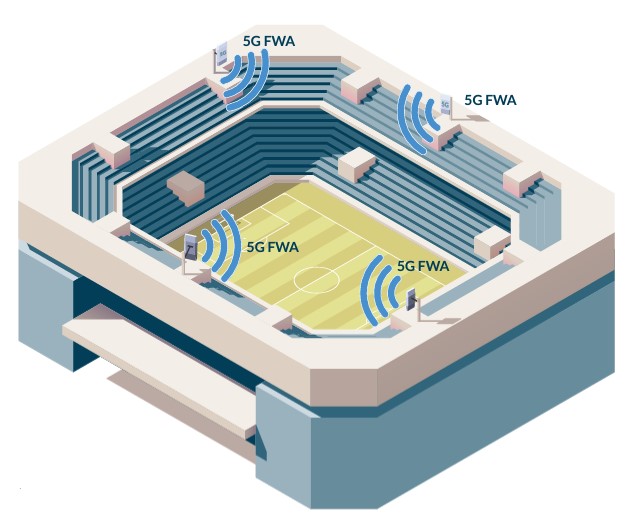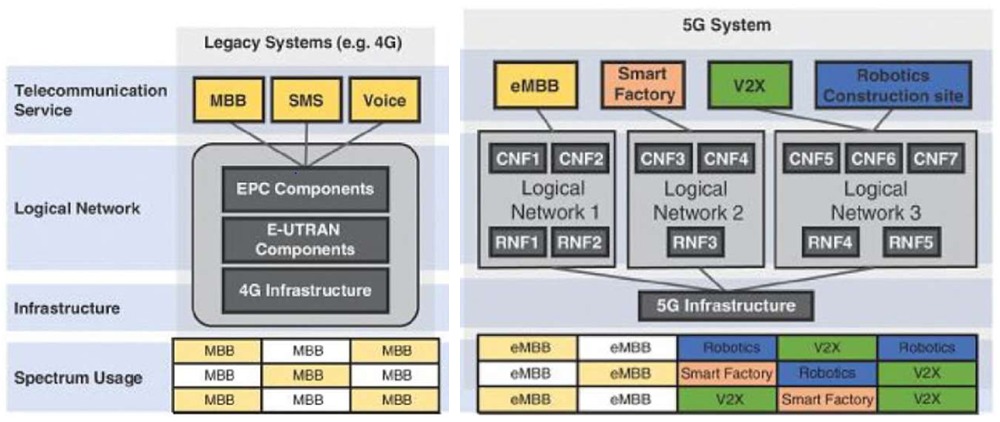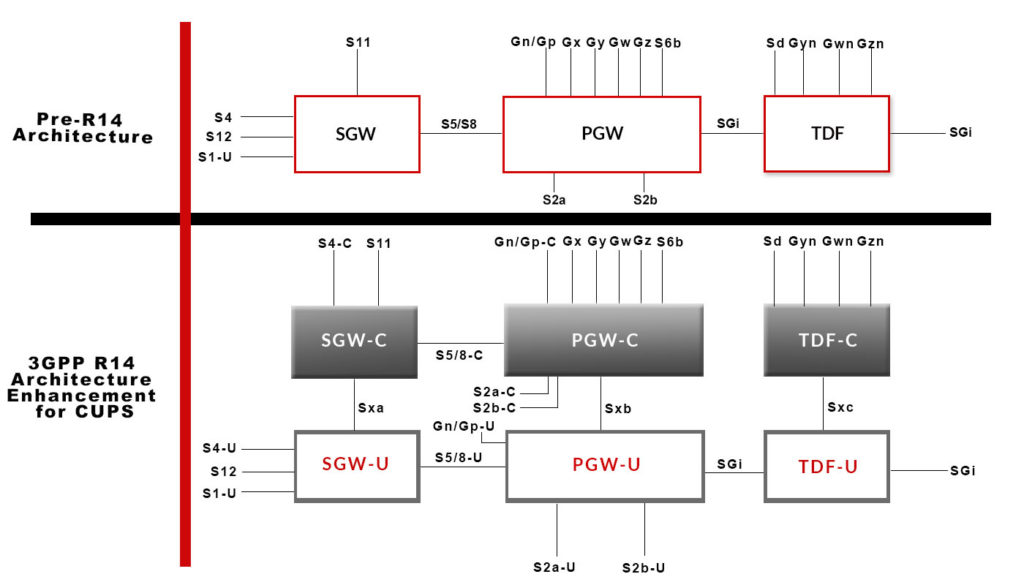5G synchronization is crucial for the development and expansion of the new 5G networks. Especially when it comes to 5G Synchronization in TDD (Time-Division-Duplex) systems, where the resources are shared in the time domain and there are more strict requirements. In cases when there is no time sync, typically guard bands between the operators are required to avoid interference. Furthermore, another more costly solution is for each Operator to design specific receiver filters. On the other hand, with Time Sync, a global eco-system with common hardware and sync protocol support can be used, together with the application of band-specific receivers and appropriate filter design.
5G Synchronization principles
The general requirement on 5G synchronization is that all gNBs must be synchronized in time. This will provide the accuracy needed to operate in the 5G NR TDD domain and support demanding services, especially those that require higher reliability and lower latency, such as Ultra-Reliable Low-Latency Communications (URLLC). Synchronization in the transmission path can be achieved by either enabling IEEE1588v2 protocol in the transmission elements or using a global navigation satellite system (GNSS), such as Global Positioning System (GPS) and Global Navigation Satellite System (GLONASS). However, synchronization among all operators using the same frequency band is also necessary. Otherwise, Passive Inter-modulation (PIM) and spurious emissions may cause Uplink/Downlink interference. International cooperation is also required, by standardizing the beginning of the radio frame, specifically the system frame number (SFN), to an epoch, a known point in time.
5G Synchronization scenarios
On a 5G NR network, there might be the scenario where a 5G NR TDD network coexists with another network, such as LTE TDD, WiMAX, TD-SCDMA, and PHS, and their spectrum is close to each other. If the frame offset modification causes intra-RAT or inter-RAT uplink and downlink timeslot un-alignment, and significant mutual interference may occur.
Different systems could have differences in the frame synchronization to the PPS timing pulse. This parameter can be used to adjust an air interface timing freely as for a 1PPS synchronization pulse. The User Equipment must measure NR neighbors when operating on LTE looking for NR cells and when on NR looking for NR cells. At least one SSB from each NR neighbor cell must coincide with the measurement gap. The eNB and the UE must be time-synchronized with 0.5 ms accuracy (1 ms TAE), as per 36.133, section 7.15.2.
In Frequency synchronization, NTP and Synch-E can be used for NR FDD. This is the same type of synchronization solution as for 4G and can provide a time-to-market advantage. In 5G Non-Standalone FDD deployment, frequency synch is supported while mobility is handled by 4G. In 5G Standalone FDD, such mobility is not supported, since in cases where the SSB of the target cell is not found, there is handover failure, idle mode, and re-establishment.
On the other hand, Partial timing support (PTS), is a semi-loose time synchronization and is recommended for NR FDD (0,5 ms), whereas full-timing support (FTS) synchronization or GNSS is required for NR TDD (± 1,5 us).
NR FDD (NSA) without proper synchronization
In this scenario, the inter-site NR addition success rate is expected to be low. The NR-NR handover in NSA is unreliable since the NR drops and re-establishes new cells after the LTE handover. In site A, the UE is in 4G+5G EN-DC operation mode. Then, the handover of 4G takes place from site A to site B. The 5G Cell Site A is dropped, and EN-DC is re-established with 4G+5G EN-DC at Site B. Increased inter-site cell interference may occur due to the loose synchronization, especially in DSS configuration.
NR FDD (SA) without proper synchronization
In 5G NR FDD SA mode, again, the inter-site NR Addition success rate is expected to be low. The UE uses 5G SA in Site A when the handover is attempted from site A to site B. If SSB is found, the handover takes place. If SSB is not found, the handover fails, and the UE is in an idle state. In the case of an idle state, the service is re-established on Site B. As in the NSA example above, increased inter-site cell interference may occur due to loose synchronization, especially in DSS configuration.
RAN GM distribution with ITU-T G.8275.1
The RAN Grandmaster is distributed via ITU-T G.8275.1 in all cluster elements. This is suitable for any TDD system where there are clusters with baseband. G.8275.1 can be configured between sites, and the GM is configured in the baseband or router equipment.
GNSS is used as a time reference to the GM. The synchronization signal is then distributed to all transmission elements using PTP IEEEE1588v2 according to telecom profile ITU-T G.8275.1. Boundary Clock (BC) is configured in all nodes to make easier expansions and reuse configurations. The cost and time to service can be reduced by not having GNSS receivers on all sites and using PTP support and configuration in the network segment.
Sync source redundancy is needed in the network segment. The Full Timing Support (G.8271.1) budget must be fulfilled.
RAN GM distribution with G.8275.1 & APTS
In this scenario, the RAN Grandmaster is distributed by ITU-T G.8275.1 and Assisted Partial Timing Support (APTS) acts as a Backup. This is suitable for any TDD system where there are clusters with baseband, and there is a central Grandmaster with G.8275.2 support. An assisting reference (APTS, G.8275.2) can be set up as a backup to keep the time and phase accuracy for a limited time. This will protect the system against GNSS outages and provide a comprehensive solution with a local time and phase synchronization source. In this case, the support for PTP (APTS, G.8275.2) is not needed in every node in L3 Unicast domain. Furthermore, properly configuring the QoS is required in order to avoid extensive PDV.
G.8275.2 Partial Timing Support (PTS)
Partial Timing Support (PTS) is a semi-loose time sync solution that is used for FDD systems, typically with 0.5 ms accuracy. The PTP over IP is used between the Grandmaster and basebands with ITU-T G.8275.2. An audit of the Backhaul network is needed before implementation. This system supports Inter-Carrier Aggregation and is more suitable for an FDD implementation since there is a central Grandmaster with G.8275.2 support, while no G.8275.1 nor GNSS are available on site.
RAN with PTP Time & Phase Sync Source in the Transport
The Grandmaster is configured in the Transport Network and is distributed using PTP (IEEE1588v2) according to the Telecom Profile (G.8275.1). In this case, G.8275.1 support is needed in all network elements in the sync path. It is hard to fulfill the Full Timing Support (G.8271.1) budget requirements. Therefore, a boundary clock still has to be configured in all nodes for better overall performance. Redundancy can be configured in the Transport network. This scenario is sensitive to the sum of the link asymmetries in the synchronization path, where accuracy and holdover are affected.
RAN Synchronization with GNSS Only
The Grandmaster is configured in all baseband equipment to provide a reference synchronization signal to the radio interface. When using a GNSS as a time reference to the GM, there is no PTP configuration in the transport elements. However, a loss of the GNSS signal affects overall cell availability, since time and phase synchronization is lost shortly after a failure. For Redundancy Sync-E or APTS at the baseband can be applied distributed from the primary reference time clock (PRTC).













